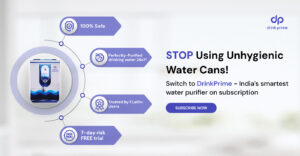Water is the main source of life, an important component that supports all living creatures on our planet. Clean and safe drinking water isn’t a need; it’s an essential human right. In a world where contamination and defilement are on the rise, guaranteeing that the water we consume is free from impurities has ended up a growing concern. Usually, this is where water purifiers come into play, as they have advanced into irreplaceable machines for families around the globe. Water purifier technology has become a lifesaver over the decades by providing clean water to a lot of people.
Latest in Water Purifier technology
These days several advanced technologies and innovations are being used in water purifiers to ensure the delivery of safe and clean drinking water. Here are some of the latest water purifier technology that are in use:
1. Reverse Osmosis (RO) Technology
RO technology is widely used in water purifiers. It involves forcing water through a semipermeable membrane to remove contaminants, impurities, and minerals. Some advanced RO systems also incorporate additional stages like UV purification.
2. Ultraviolet (UV) Purification
UV technology uses ultraviolet light to disinfect water and kill bacteria, viruses, and other microorganisms. UV water purifier technology is effective at ensuring microbiologically safe water.
3. Ultrafiltration (UF) Technology
UF membranes have smaller pores than RO membranes, making them effective at removing bacteria, viruses, and larger particles. UF is often used along with other filtration technologies.
4. Activated Carbon Filtration

Activated carbon filters are effective at removing chlorine, organic compounds, and odors from water. Advanced water purifiers may use multiple stages of activated carbon for improved performance.
5. Smart Purifiers
Some modern water purifiers are equipped with sensors and IoT (Internet of Things) capabilities. They can monitor water quality in real time and provide alerts or data to users via smartphone apps. DrinkPrime provides a user-friendly app that allows users to monitor their water levels and even place orders.
Apart from these technologies, there is one other technology in water purification that is trending these days.
6. Nanofiltration (NF)
Nanofiltration (NF) is a filtration process is a water purifier technology that uses semi-permeable membranes to separate and purify water by removing particles and solutes with a molecular weight between 200 and 1,000 daltons. NF is often used for tasks like water softening, color removal, and selectively reducing specific contaminants in water due to its ability to let certain ions and molecules pass while blocking others. This technology finds applications in water treatment, food and beverage processing, and various industrial processes requiring precise control over water composition.
Future of water purification
The future of water purifiers is promising and will likely bring about several key advancements.
1. Affordability
First, we can expect increased efficiency and affordability. As technology improves, water purifiers will become more energy-efficient and cost-effective, making clean drinking water more accessible to people worldwide.
2. Smarter water purifiers

Next, innovation will lead to smart water purifiers. These devices will be equipped with sensors and advanced monitoring capabilities, allowing users to receive real-time information about water quality. This will help people make informed decisions about their water consumption.
3. Sustainability
Furthermore, the materials used in water purifiers will continue to evolve. Manufacturers will develop more sustainable and eco-friendly options, reducing their environmental impact.
4. Nanotechnology
Advancements in nanotechnology and membrane technology will play a significant role in the future of water purification. Nanofiltration and other cutting-edge techniques will enhance the efficiency of water treatment, removing even smaller particles and contaminants.
Overall, the future of water purifiers holds the promise of cleaner, safer, and more accessible drinking water for people around the world. As technology continues to advance, we can expect innovative solutions that address water quality challenges and contribute to a healthier planet with a healthier generation of people.
Emerging water treatment technologies
Emerging water treatment technologies are like the superheroes of clean water. They’re new, exciting ways to make sure the water we drink is safe and healthy. Here are ten of these cool technologies:
1. Advanced Oxidation Processes (AOPs)
Think of AOPs as water cleaners with special powers. They use things like ozone and UV light to break down and remove bad stuff, like chemicals and medicines, from water.
2. Electrocoagulation
Imagine using electricity to make tiny particles in the water stick together and then easily remove them. That’s what electrocoagulation does, and it helps get rid of dirt and heavy metals.
3. Graphene-based Filters
Graphene is like a super-strong and super-thin material. It’s used to create filters that can catch all sorts of bad things in water, from metals to oils.
4. Forward Osmosis (FO)
FO is like a water magnet. It uses special membranes to attract water and leave behind the bad stuff. It’s great for turning salty water into fresh water.
5. Membrane Distillation
Picture water turning into steam, leaving behind all the dirty stuff. Membrane distillation does just that, making water clean by using heat.
6. Biological Nutrient Removal (BNR)
BNR uses helpful bacteria to remove things like nitrogen and phosphorus, making wastewater cleaner.
7. Carbon Nanotube Filters
Carbon nanotubes are like tiny straws that can suck up pollutants in water, like metals and chemicals. They’re like powerful filters.
8. Solar Desalination
Imagine using the sun to turn salty water into fresh water. That’s what solar desalination does, providing clean water in sunny places.
9. Microbial Fuel Cells (MFCs)
MFCs are like machines that eat dirt in water and turn it into electricity. They help clean water and produce power at the same time.
10. Emerging Nanomaterials
Nanomaterials are like super-small particles that can grab onto bad stuff in water. They can help make water cleaner and safer.
Get 7 Days Risk Free Trial
Conclusion
With the change and improvement in water purifier technology, every day there is one or the other new thing that arises in every field. Making use of this technology, the water purifiers are also changing accordingly to provide clean and safe drinking water to all while simultaneously preserving nature.




